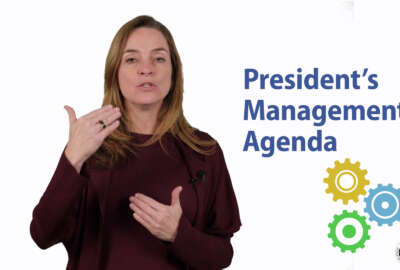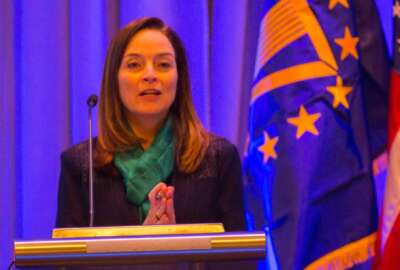
NIH’s employee engagement tool and strategy gets validation from the top
Evaluating and improving employee engagement gets easier with a tool from a small team of senior leaders at the National Institutes of Health. And the team is d...
What started as a simple attempt by a small team at the National Institutes of Health to sift through the annual avalanche of employee engagement data has stretched far and wide across government over the past year.
Faced with too much data, senior leaders at NIH’s National Institute of Diabetes and Digestive and Kidney Diseases (NIDDK) developed a tool to more quickly parse through the results of the Federal Employee Viewpoint Survey (FEVS) from the Office of Personnel Management.
The tool, called the Employee Viewpoint Survey Analysis and Results Tool, or EVS ART, helped NIDDK gain a clearer picture of engagement — and develop strategies that are showing noticeable improvements — at the organization.
Now, with help from top leaders in the Trump administration, they’re on a mission to share the tool with the rest of government.
The NIDDK team has met with and trained leaders from 15 cabinet departments, in addition to several dozen agencies and subcomponents, on the tool and its capabilities over the past year. They have spoken to more than 1,000 federal employees about EVS ART, and they have more webinars planned to reach several thousand more.
“We are now on a national platform to be able to share this as broadly as possible [and] to meet with organizations and the senior-most leaders to talk about … the power of this tool,” Camille Hoover, NIDDK’s executive officer, said in an interview with Federal News Network. “We provide custom design to them. We talk about how they can put in place impactful initiatives and they actually move their organization’s performance from one year to the next.”
Hoover is also one of the co-chairs of the employee performance and engagement subcommittee tasked with working on the modern federal workforce cross-agency priority goal on the President’s Management Agenda.
The Trump administration has tasked all major agencies and subcomponents to identify its bottom 20% on last year’s federal employee engagement index and improve those scores by 20% by the end of 2020.
The Office of Personnel Management and Office of Management and Budget have flagged EVS ART as a best practice to help agencies more quickly evaluate employee engagement — and make headway on that goal.
‘We are working on [finding] the best practices … and how can we share them consistently across government?” Hoover said. “How can we build a community of practices and collaborate and have cross-agency connections to move the engagement platform forward.”
The tool itself is an Excel-based program that pulls data points from each of the main themes on the annual OPM survey, such as employee engagement, intrinsic work experience and global satisfaction. The tool organizes the survey results based on those themes by agency, subcomponent and office, and it shows the change in responses for a specific item over the years.
A “heat map” feature uses colors to show managers their highest and lowest scores — areas that might be strengths or challenges for the agency or office.
EVS ART now includes an “at a glance” feature, which summarizes an organization’s key points of progress and areas for improvement, in addition to an action-planning tool.
“It’s a tab that will auto-fill if you enter in information on the questions that you want to look at and target,” Robin Klevins, a senior management analyst for NIDDK, said. “It’s a starting point, actually, for a bigger action plan.”
Faster employee engagement analysis, faster results
For Hoover and her team at NIDDK, progress on employee engagement starts with moving at deliberate speed to parse through the FEVS results and then develop an action plan to address the findings.
“People were spending weeks if not months working through the data,” Klevins said. “By the time the leaders received analysis, if they received analysis, we were on the heels of the next survey, so employees were not seeing a lot of change from the next year to the next. This allows us to get the information to decision-makers out much sooner.”
Engagement experts in the federal space have often said that employees’ perceptions of whether their agency will use the results of the viewpoint survey to make noticeable differences within their organizations paint the truest picture of satisfaction within the workforce.
Just 41 percent of federal employees across government in 2018 said they believed FEVS results would be used to make their agencies better places to work.
About 49 percent of NIDDK employees a few years ago agreed with that statement. Today, the organization’s score on that question sits at 74 percent, Hoover said.
The institute’s director has sent out full employee engagement results to the entire organization of 1,300 people. Hoover and Klevins meet with managers to discuss specific results within their individual offices. They hold focus groups throughout the year to regularly solicit employee feedback.
In addition, the organization also recently created formal career development programs, a new community for rising supervisors and a mentoring program.
“These are grassroots efforts that don’t take money,” Hoover said. “They don’t take you having to have contracts and a lot of resources and funds. If you have people who are passionate and care about the people of the organization and want to provide training and development for the workforce … it’s easy to corral that energy and get a group together that’s going to give back.”
Initial uptake shows promising results
With NIDDK as a model, the Department of Health and Human Services is taking a similar approach. HHS is also using EVS ART to parse through large quantities of employee engagement data.
“We have colleagues who have gone from spending 72 days doing reports to one day,” Klevins said. “We have a colleague on the West Coast who went from 200 hours to 40 minutes. We have a colleague at NIH who spent 30 hours and now does the same, if not maybe even a more robust report, in five minutes.”
That report used to cost NIH $1,350 to produce, Klevins added. Now, it costs $3.75.
HHS is using the data to evaluate and develop specific employee engagement initiatives tailored toward individual offices and subcomponents, Hoover said.
Meanwhile, Hoover and Klevins said they’ve seen interest in employee engagement grow stronger within agencies over the past year. Their initial conversations about EVS ART started with agency human resources staff.
Now, deputy secretaries and agency administrators are sitting in those meetings, they said.
“The highest level has to support it, but beyond that, the people on the front lines have to carry that forward, emulate what you have as your vision and put forth a plan that’s going to affect change,” Hoover said.
All federal employees from any agency can find EVS ART on OMB’s community MAX portal. The tool is free of charge.
Copyright © 2024 Federal News Network. All rights reserved. This website is not intended for users located within the European Economic Area.
Nicole Ogrysko is a reporter for Federal News Network focusing on the federal workforce and federal pay and benefits.
Follow @nogryskoWFED






